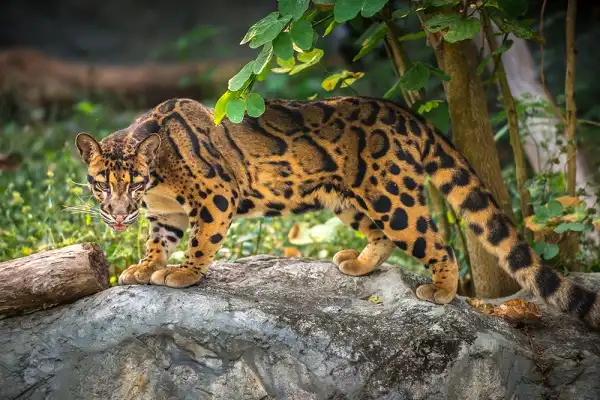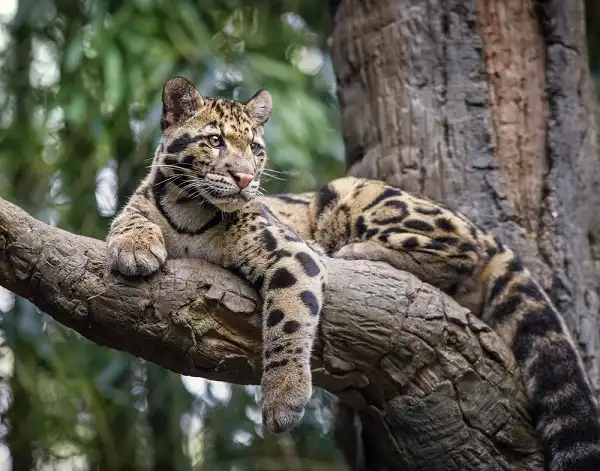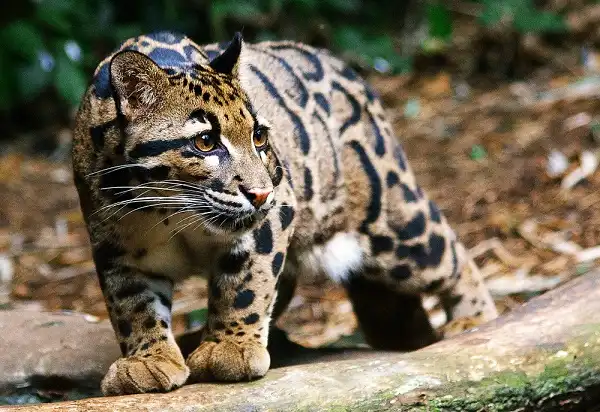Experience the exotic beauty of a rare sight – the captivating clouded leopard! This agile and mysterious creature has enchanted conservationists for centuries, its coat pattern resembling clouds in an elegant tapestry. The elusive misty cat is considered by many to be among the most difficult animals to spot in nature due to their highly secretive behaviors. But with determination and patience, you could be one of the privileged few lucky enough to witness this impressive animal. Keep reading for an inside glimpse into these enchanting creatures that call the tropical forests home.

Clouded Leopard Description
The clouded leopard is a medium-sized cat that is native to the tropical forests of Southeast Asia. They are recognizable by their unique coat pattern of large, dark spots resembling clouds, with each individual animal’s markings being unique and distinct. It has a relatively slender body and powerful legs, allowing it to climb trees with surprising agility. Its short fur also helps keep it cool in its warm habitat, while its long tail provides balance for when it jumps from tree to tree. The clouded leopard possesses an incredibly efficient set of retractable claws that allow them to move quickly through its environment without damaging or losing its grip on its prey. Their sharp teeth are designed specifically for hunting smaller animals. Moreover, they have excellent eyesight which helps them locate potential prey even in dense vegetation or at night time.
Clouded Leopard Habitat
The clouded leopard is found primarily in the tropical and subtropical forests of South and Southeast Asia, including Indonesia, India, Bhutan, Bangladesh, Nepal, Myanmar, and China. They prefer areas with dense canopy cover that provides them with ample opportunity to hunt as well as protection from predators. They also inhabit areas near rivers and streams for easy access to water. These cats are most active during the night when they search for food in the treetops and nearby ground vegetation. Clouded leopards have adapted to different types of habitats ranging from lowland rainforests and high mountain forests up to 3,000 meters above sea level. However, they require large areas of forest habitat for their survival and may move through several patches of forest in search of prey or mates. This wide-ranging behavior has put them at risk since many of these patches are disappearing due to deforestation. As a result, their populations are declining rapidly due to habitat loss.
Clouded Leopard Diet
The clouded leopard’s diet consists mainly of smaller animals such as birds, reptiles, amphibians, and small mammals. These agile cats are stealthy hunters and use their powerful legs and retractable claws to climb trees with ease in search of prey. They have excellent eyesight which allows them to spot potential prey even in dense vegetation or at night time. Their sharp teeth are designed specifically for tearing apart their prey, and their short fur helps keep them cool while they hunt. Although they mainly consume smaller animals such as mice and birds, they have also been known to feed on larger prey such as young deer and wild pigs if given the opportunity. In addition to meat, the clouded leopard also consumes a variety of fruits and vegetables in order to obtain essential vitamins and minerals. This helps them stay healthy during times when hunting may be difficult due to weather or other factors.

Clouded Leopard Size
The clouded leopard is a medium-sized cat that typically measures between three and 5 feet long from head to tail, with males typically being larger than females. The short fur helps keep them cool in their warm habitat, while their powerful legs and retractable claws allow them to climb trees with ease. They have an average weight of 22–49 pounds (10–22 kg), but some individuals can grow up to 70 pounds (32 kg). Their large heads compared to other cats are an adaptation to help the species capture and hold prey in its jaws. Their long tails can measure up to 28 inches (71 cm) which helps provide balance when jumping from tree to tree. Clouded leopards also have incredibly sharp senses; they possess excellent night vision and hearing abilities, making them proficient hunters even in the dark. Additionally, their large eyes provide an up-close look at potential prey or predators nearby.
Clouded Leopard Lifespan
The average lifespan of the clouded leopard in the wild is estimated to be about 10 years. However, they have been known to live up to 15 years and longer in captivity. The oldest recorded clouded leopard was 22 years old when it passed away in captivity. In the wild, the primary factors that affect their lifespan are predation, disease, and environmental conditions. As predators, they can fall prey to larger cats such as tigers or humans who hunt them for their fur. They are also vulnerable to diseases like rabies which spread easily among animals living in close proximity. Besides these external factors, there are several internal factors that can also reduce their lifespan such as genetic defects or metabolic diseases caused by a lack of proper nutrition.
Clouded leopards reach sexual maturity at around 2 years old and may mate for life with one partner if living in an area with a high population density. If not, they may move on to other partners when searching for food or a mate – this behavior helps keep the gene pool healthy and ensures that their offspring will have a better chance of survival. It is important to note that deforestation has had a devastating effect on the clouded leopard population due to habitat loss. This decrease in their natural habitats forces them into areas with higher competition for resources which could potentially shorten their lifespans even further if left unchecked. Conservation efforts must be made in order to ensure that these majestic creatures continue roaming our forests freely for generations to come!
Clouded Leopard Behavior
The clouded leopard is an elusive and mysterious creature, known for its secretive behavior and solitary lifestyle. They are typically nocturnal animals and prefer to hunt during the night when their powerful senses can be used to their advantage. During the day, they often rest in thick vegetation or trees, blending into their surroundings to avoid being detected by larger predators. These agile cats are proficient climbers and use their strong legs and retractable claws to scale trees with ease. In addition, they have excellent night vision which allows them to spot potential prey or predators even in dense forests at dusk or dawn.
When threatened, these cats may hiss or growl as a warning sign before using their sharp teeth and claws as a form of defense. Clouded leopards are also skilled hunters; they will stalk their prey until it is close enough to pounce on before using their powerful jaws and teeth to take it down. They usually hunt alone but have been known to work together in small groups if necessary. Furthermore, they tend to select areas with abundant prey so that they can feed regularly without having to search too far from home. In addition to hunting for food, these cats also use scent marking as a way of communicating with other members of their species in order to avoid conflicts over territories or mates.

Clouded Leopard Speed
The clouded leopard is known for its incredible agility and speed, allowing them to outrun most predators. They can reach speeds of up to 37 mph (60 km/h) over short distances and have been known to jump up to 16 feet (5 m) from tree to tree. Their long legs and powerful muscles help propel them quickly across the ground and up into trees where they can rest or hide from potential danger. Their sharp claws also aid in their speed, digging into tree bark and helping them climb faster. In addition, their short fur makes them more aerodynamic when running at high speeds, reducing drag and allowing them to move faster. This combination of physical characteristics allows them to hunt successfully in even the densest forests by outrunning prey or reaching higher branches before their enemies can catch up. The clouded leopard’s speed is not limited only to land; these cats are excellent swimmers too! With powerful webbed feet, they can paddle through the water with ease–providing a unique escape route when needed.
Clouded Leopard Hunting
The clouded leopard is an expert hunter, using its agile body and sharp senses to track down prey. They are formidable predators that have adapted to hunting in the dense forests of the tropics. Their long legs and powerful muscles make them incredibly fast, allowing them to outrun most animals they come across. In addition, their retractable claws give them superior climbing abilities which can help them scale trees quickly and access higher areas for scouting or shelter. Their acute sense of smell helps them to accurately locate prey even in thick foliage, while their sharp eyesight allows them to hunt even at night. To get close enough for a successful attack, they often stalk their prey carefully until it is within striking distance.
When ready to pounce, they use their powerful jaws and sharp teeth to take down anything from small rodents to larger animals like deer or wild pigs. In certain regions where food availability is low, clouded leopards have been known to hunt in groups – this increases the chances of success by surrounding potential prey and ensuring that no single animal can escape. Furthermore, these cats also employ a technique known as ‘mantling’ when defending their catch from other predators; they will extend their paws wide and arch their back over the kill as if shielding it from view or attack.

Conclusion
The clouded leopard is an amazing species with many incredible physical and behavioral adaptations that have allowed it to remain a successful hunter in the dense forests of the tropics for centuries. Their agility, speed, sharp senses, and powerful jaws make them formidable predators that can take down even large prey with ease. In addition, they employ a variety of tactics such as scent marking and mantling to communicate with others or defend their catch from other animals. All of these unique traits have made the clouded leopard one of the most magnificent cats on Earth – let’s do our part to protect this majestic species so that future generations can continue admiring its fascinating behaviors!
Frequently Asked Question


